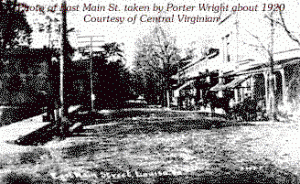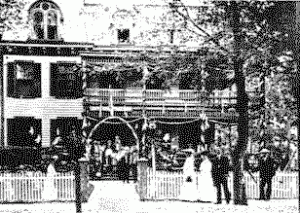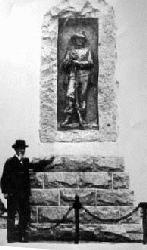LOUISA TOWN HISTORICAL NOTES
By Porter Wright
It started in JOUETT’S TAVERN…
The ordinary or tavern, located at the site of the courthouse, served as a place of refreshment and lodging for the Justices and visitors to the monthly courts and also to such travelers who might go through the county on the roads from Richmond to Charlottesville. This, however, was not the only function of the establishment. It served as a gathering place for persons on scores of duties or pleasure bent. Legal notices and newspapers were on file, mail was distributed and the tap room was a clearinghouse for news and gossip. The tavern carried a small stock of necessities which could be purchased by the surrounding populace.
No record exists as to the growth of this plantation settlement, which, on Court days, became a scene of commercial activity, but it is to be hoped that Mr. Jouett and his successors served their customers with a more substantial and cleanly fare than that which prevailed in 1782, when the Marquis de Chastellux made his pilgrimage through Louisa Courthouse on his way to visit Mr. Jefferson at Monticello.
In his account of his trip, he records that on 17 April, 1782, while traveling from Willis’ Ordinary, which was located in the vicinity of where Bumpass or Buckner are today, he still had about twenty seven or eight miles to ride to the only tavern where it was possible to stay before reaching Mr. Jefferson’s – this being Boswell’s Tavern. He had been strongly advised by M. de Rochambeau, who had traveled the same road two months before, not to sleep at the tavern at Louisa Courthouse, it being the worst lodging he had found in America. However, in his curiosity to see the place and using the pretense of inquiring for the road, Chastellux went in and saw that there was no other lodging for travelers than the landlord’s own room.
The landlord, Major Thomas Johnson, was a man of enormous girth – to the extent that he was confined to an armchair in which he lived, slept, and ate, unable to arise. Rochambeau described the place as the dirtiest, most shocking, most stinking barracks he had ever seen and that the Major lived with a wretched woman who wasted his property and left him to die of uncleanness and misery. This was the same Major Johnson who opposed the removal of the courthouse to another site in 1787, no doubt due to the fact that he, as a Justice would be unable to attend court on account of his highly inflated condition.
THE POST ROAD
An Act of Congress, approved 23 April 1800, established a “postroad from Fredericksburg, by Spotsylvania Courthouse and Louisa Courthouse to Columbia.” This road was to connect the Rappahannock River and the James River and is roughly Route 208 of today, which reaches from Interstate 95 to Interstate 64 at Ferncliff.
A postoffice was established at Louisa Courthouse on 19 September, 1800, and the first postmaster was Ludlow Branham. The mail, at this time was carried by postriders and stage coaches and apparently assumed some degree of regularity which had not before prevailed.
No actual records of the village exists as to its content in the manner of occupants or business until the publication of a “Gazeteer of Virginia” by John Martin in 1835.
In this work, Louisa Court House is described as a Post Village, located 110 miles southwest of Washington; 54 miles northeast of Richmond and 30 miles from Charlottesville. It contained, besides the Courthouse, jail, and a large house of worship, the following:
Four stores (possible general merchandise stores); a silversmith; blacksmith; 2 carriage makers; a shoe maker; cabinet maker; saddler; 2 taverns; a milliner; 2 lawyer’s offices and a physician’s. A total of nineteen places of business but no mention of the population of the Village as there were, at that time, no boundary lines.
LOUISA RAILROAD
On 1 December, 1838, the Louisa Railroad, which had been started in 1836, reached Louisa Courthouse and thus began a contact with the outside world for what had been a landlocked settlement, served only by post roads and wagon trails and which had grown to the status of a village, with streets, stores, and professional men. The coming of the railroad proved to be a boon to the village in later years and was a contributing factor to its growth.
LOUISA INCORPORATES
At the time of the incorporation of Louisa Courthouse as a town, Chataigne and Ellis, in their Virginia Business Directory and Gazeteer, show that the town contained about 250 inhabitants. It also included four churches, a hotel, seven lawyers, one druggist, one saddler, one milliner, one confectioner, a lumber firm, a music store, seven general stores, one general merchandise merchant, and one liquor dealer (exclusively), one grocer, one flour mill, one distiller, and a tinner; in all, twenty-seven places of business.
The Town of Louisa was incorporated under Chapter 125 of the Acts of the General Assembly 1872-1873 and approved on 8 March, 1873.
The boundaries of the Town were stated in the Act, but the designation of the various corners and markers were so vague that it is almost impossible to determine form the descriptions exactly where they lay, as it called for lines to trees, fence corners, posts, etc. A plat of the boundaries does exist and from it can be determined the approximate boundaries.
THE EARLY GOVERNMENT
The officers were to consist of seven trustees, who would compose the town council, and the following persons were named in the Act: George J. Sumner, Hyman Levy, F.W. Jones, Jesse W. Melton, Henry W. Murray, Dr. Gulielmus Smith, and Samuel H. Parsons. They were given the power to pass all by-laws and ordinances for the governing of the town; provide for keeping the streets; grading, paving, and making such other necessary improvements. To accomplish these ends, they were empowered to levy such tax as they might deem proper on all property in town not exceeding fifty cents on the one hundred dollars and on all avocations, professions, and business as were subject to taxation by the revenue laws of the state.
The Board of Trustees were from their own body, to elect a president, who would preside at all meetings, and when they were equally divided should, in addition to his own vote, give the deciding vote.
Annual elections were to be held on the first Monday in November and seven trustees and one town sergeant were to be elected by the qualified voters. The Trustees were empowered to elect a secretary to the council, who would be ex-officio treasurer of the town and who was to give bond for all funds that would come into his hands. The collection of taxes, however, was one of the duties of the town sergeant.
BUILDING THE INFRASTRUCTURE
It might be well to recall here that 1873 was the beginning of the financial panic under President Grant which was to last for six years, but this apparently did not have a tremendous effect upon Louisa, inasmuch as we had never recovered from the so-called Reconstruction after the Civil War.
The first meeting of the Town Council was held on 8 March, 1873, with the gentlemen named in the Charter in attendance. From this group, George J. Sumner, a merchant of the town, was elected President or Mayor of the Council and served for two terms. At this meeting, a set of Bylaws or ordinances by which the town would be governed were adopted. These were mostly police regulations and the penalties which would be assessed for failure to observe them.
The next few years, according to the records, were concerned with such mundane matters as the repairs of streets and sidewalks and the general administration of the town government. In 1878, the first street lights, twelve in number, were installed and were large oil lamps on posts placed at strategic locations in the Town. These were attended to by Mr. W.H. Vaden, who came around each morning with a small ladder, a pair of scissors for trimming the wicks, a can of oil, and tissue paper for cleaning the globes. He would then return about dusk and light the lamps for the night. It was not until 1925 that adequate electric lights for both municipal and private homes was secured from the Louisa Light & Power Company at Mineral, an operation conducted by the Fisher brothers. Prior to this, there had been several attempts to operate a small light plant using direct current furnished by a gasoline engine and a generator, but this was never successful. Several of the stores had their own private Delco plants and some even used gas for lighting.
The sidewalks in 1873 were mostly plank walks laid in the Main Street business area with walks made of tanbark for the outlying sections. By the early 1900’s, these had gradually been replaced by some cement sidewalks in the business area, with the merchants paying a proportionate part of the cost, but it was not until 1906 that, by aid of a $6,000 bond issue, cement walks were completed to the corporate limits of the town.
A disastrous fire in January 1888 almost completely wiped out the entire east side of Main Street and paralyzed the business district. This was the block directly across the street from the courthouse. It was several years before the town recovered from this loss and the slow task of rebuilding is shown on insurance maps owned by the Louisa County Historical Society.
The water supply for the town in 1873 consisted of individual wells and a public well located at the corner of the courthouse property which was jointly owned by the county and the town. The county relinquished its entire interest in the well in 1916 and the town began furnishing water in limited quantities to the outlying properties in this year. The next water system was installed in 1926 at a cost of $35,000 which was obtained by a bond issue. This system consisted primarily of a wellhouse, spring and pumps to provide water. Fire plugs were installed and a volunteer fire department was organized, their first building being constructed in 1929. The company has rendered invaluable service to the town and surrounding community over the years.
In 1935, the town purchased ten acres of land about one and one-half miles east of the town to be used as a municipally owned cemetery with perpetual care. This has been enlarged by the purchase of adjacent land and has proven to be a beautifully kept project.

The streets of the town from 1873 until around 1921 were dirt roads supplemented by an occasional fifty-ton car of gravel which was placed in the most strategic and well needed places. In 1921, the State Highway Department ran its first hardsurfaced road through the town of what was then State Route 39. This road was an eighteen foot wide cement ribbon which left a considerable amount of unpaved street on each side. This condition was remedied in 1928 by an extension of a cement roadway from the highway to the curbs on both sides by the town through the business section, thus eliminating the existing expanse of dirt and muddy problems of the portions of the street.

A small sewer disposal system had been installed back in the 1920’s which only took care of portions of the landowners. A majority of them had septic tanks and in 1958, the town secured a bond issue in the amount of $240,000 and constructed the present system. All of these improvements meant the passing of the outhouse which had been a feature of the town at its beginning and which was a subject of some of the first ordinances.
Of the seven churches now in the town, four of them were in existence when the town was incorporated. The old Haley High School on Elm Street was succeeded by the Louisa High School (now empty) on Fredericksburg Avenue in 1907. This was completely gutted by fire in February 1924 and was rebuilt and continued as a high school until around 1940. An alert Rescue Squad presently takes care of emergencies and has rendered excellent service.
In the late 1890’s and on through until the 1920’s, Louisa was known as a summer resort. This was before the advent of good roads and the automobile. There were several ladies – Mrs. Douglas Chaney and Mrs. Charles Donnally – who had large homes and took in what we called “summer boarders” along with the Louisa Hotel which was always filled. The people would come up from Richmond and the peninsula to get away from the hot, humid city air, and to enjoy the good country food. Mr. S.S. Griffith was operating the hotel and he had a large hardwood platform built just outside the dining room windows, with Japanese lanterns and little tables and chairs placed about the lawn, while a Victrola was played from the dining room window for dancing. It was quite a colorful sight as they all gathered there at night for a little recreation.
COURT DAYS
One of the features of the town was the attendance of large crowds from all over the county on the Court Days held in March and December of each year until the advent of the automobile, good roads and the telephone. People would come to Louisa in March to see who had lived through the winter and in December to get their Christmas “Likker”. They also brought every conceivable object which they thought they could sell or swap.

It has been estimated that literally thousands of persons would gather here on those days, some traveling all night to arrive here for the big day. A comment on the size of the crowds was made by the late John Bibb, who attended a Presidential Inauguration in Washington. Someone remarked on the size of the crowd there and John, drawing himself up in all of his dignity, laid him low by saying: “Hell, man, you have never seen a crowd until you have been to Louisa Courthouse on a March Court Day”.
The only comparable occasion was 17 August, 1905, when the present courthouse and the Confederate Monument were dedicated. A Confederate reunion was held in connection with this event and a number of outstanding speakers were present. It was estimated that an attendance of around ten thousand persons participated, which, if correct, would be the largest public gathering of any kind to assemble here.
I would like to make a comment on the population of the town. In 1873, when the town was formed, the population was given as “around 250 persons”. This did not vary for many, many years which calls to mind the town in West Virginia where the population never changed in twenty years, because every time a baby was born, a man left town. However, after the annexation in 1951, the population increased to some degree – the 1970 census being 633, while 1980 recorded 850 and the 1990 census listed 1,088 within the present corporate limits.
